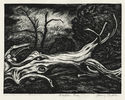
19th, 20th & 21st Century Fine Prints
707-546-7352 · fax 707-546-7924 · web: www.annexgalleries.com · email: artannex@aol.com
Harry Shokler Biography
Harry Shokler
American
1896–1978
Biography
Painter and printmaker Harry Shokler was born in Cincinnati, Ohio, on April 27, 1896, the fourth of eight children born to Russian-born Kolman and Ida Shokler. After graduating from high school, Harry Shokler enrolled in courses at the Cincinnati Art Academy, studying under portraitist Frank Duveneck, whose style would remain an influence on Shokler throughout his career. He traveled to Europe to continue his studies just before the U.S. joined World War I, at which point enlisted as a camofleur for the U.S., designing naval camouflage.
After serving, he returned to the States and enrolled in courses at the New York School of Fine and Applied Arts, followed by more studies at the Cincinnati Art Academy and summer courses at the Pennsylvania Academy of the Fine Arts. He participated in his first group exhibition at the Cincinnati Art Museum, entering an oil portrait of author Irving S. Cobb as a member of the school's Palette and Brush Club. By 1924 he had relocated to New York City and set up a studio, enrolling in courses at the Art Students' League and earning a living painting portraits of celebrities. He soon visited for the first time the popular artists' colony of Provincetown, Massachusetts, and subsequently began spending his summers there, taking courses from the many visiting lecturers and teachers.
In 1926 Shokler was awarded the Art Students' League's Frieburg Traveling Scholarship, allowing him to move to Paris to study for a year at the Academie Colarossi. While there, the Traxel Gallery in New York hung his first solo show in 1927, earning him praise from art critics, and in 1928 he had a painting accepted into the Paris Salon. This led to an invitation for a solo show at the Galerie Marsen, his first European solo exhibition. He used the last of his funds to live briefly in Tunisia, sketching and painting as he traveled around the towns and countryside. While living there he met the American writer Dahris Butterfield Martin, whom he would eventually marry.
Shokler spent much of the early 1930s showing throughout New York and the Northeast, and worked as an artist with the New Deal's Public Works of Art Project. Around this time he discovered silkscreen printmaking, and was one of printmaker Anthony Velonis' students and then compatriots in Velonis' Silk Screen Unit with the Federal Art Project in New York City. This would soon become one of Shokler's preferred mediums, and he would later become a vocal proponent of silkscreen as a non-commerical, fine art method, helping to form the National Serigraph Society in 1944.
In the mid 1930s he and Martin spent a summer in Vermont. Shokler, taken with the landscape and the inviting art scene, began traveling to South Londonderry regularly, and within a decade they bought a house there with an adjacent barn. He restored the barn and opened what would become the Shokler Art Studio, which served as a gallery, teaching space, and a hub for artists to gather. Shokler would remain a vital member of the Vermont artists' scene for the rest of his life, and would exhibit regularly with the South Vermont Arts Center in Manchester, where he also taught, as well as his own gallery. He would become known for his images of daily life in Vermont as well as New York, with special attention paid to his complex, nuanced silkscreens. In 1946 he published Artists Manual for Silk Screen Printaking (New York, American Artists Group), which was reprinted in 1960.
Shokler was a visiting lecturer at Columbia University and Princeton, as well as a private printmaking teacher who taught small workshops in Vermont and New York City. He continued to work until his death on September 11, 1978.

